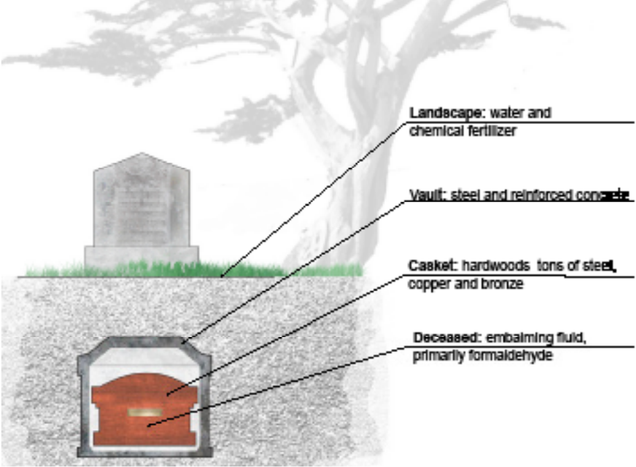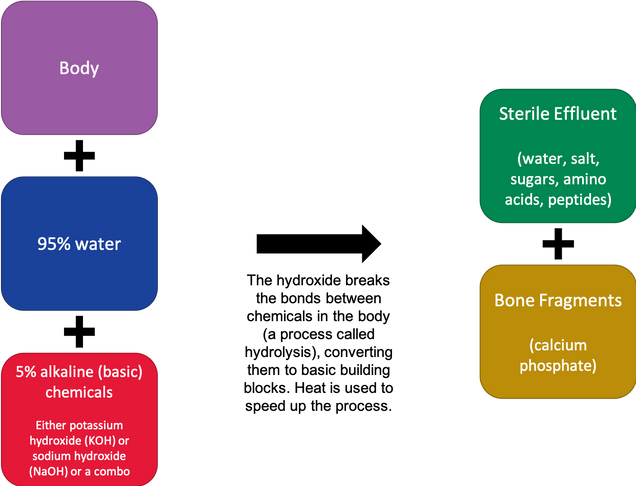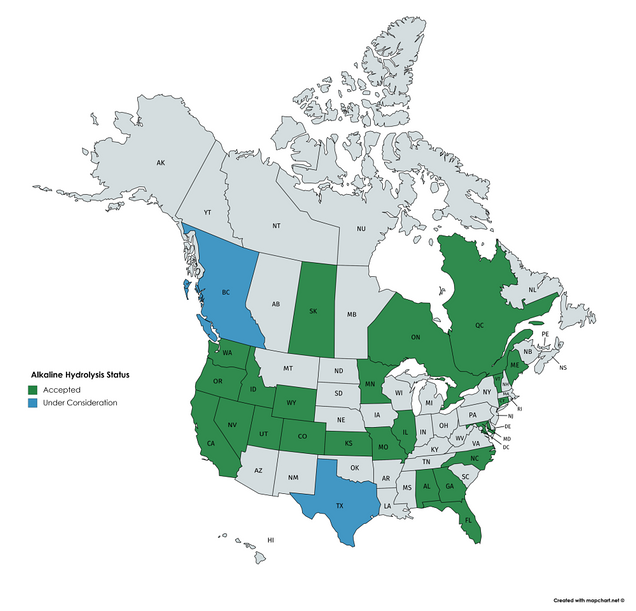Dying for a Greener Tomorrow: Legalizing Alkaline Hydrolysis
From the first intentional Neanderthal burials to Polish vampire burials and Himalayan sky burials, burial practices have long been and continue to be a large part of our cultural understanding of death and the afterlife. Today’s growing concerns with land and natural resource sustainability as well as global climate change, people look towards ways to slash their carbon footprints upon death. One emerging alternative to traditional cremation is alkaline hydrolysis (also known as resomation and biocremation).
Greater than half of the US population choose conventional modern burials upon death, which includes being filled with embalming fluid, a known carcinogen, being placed into a casket composed of imported tropical hardwoods, and buried inside a concrete-lined grave. In total, conventional burials account for “4.3 million gallons embalming fluid, 827,060 gallons of which is formaldehyde, methanol, benzene, 20 million board feet of hardwoods, including rainforest woods, 1.6 million tons of concrete, 17,000 tons of copper and bronze, 64,500 tons of steel, and [c]askets and vaults leaching iron, copper, lead, zinc, cobalt” yearly in the US. The wood alone could potentially build millions of homes. Moreover, cemetery landscapers often overwater and over fertilize these spaces to keep their green appearance. On top of these environmental effects, America is running out of space for the deceased, particularly urban centers which cannot keep pace with population growth. All of this accounts for 230 pounds of carbon footprint per traditional burial, equivalent to the average American’s three month carbon output.
 Figure 1. Alexandra Harker, through the Berkeley Planning Journal, illustrated the resource intensity of conventional modern burials.
Figure 1. Alexandra Harker, through the Berkeley Planning Journal, illustrated the resource intensity of conventional modern burials.
Traditional flame-based cremations, often thought of as a greener alternative, “uses 92 cubic [meters] of natural gas, releases 0.8 to 5.9 grams of mercury, and is equal to an [500 mile] car trip.” Interestingly enough, mercury dental fillings are one of the greatest concerns attributed to cremation. According to the Cremation Association of North America (CANA), “primary reasons for choosing cremation are; to save money (30%); because it is simpler, less emotional and more convenient (14%); and to save land (13%).” “The most recent figures from 2003 show that the U.S. cremation rate was 28% (700,000 cremations). Based upon increases in acceptance over the past five-year average, the . . . (CANA) has forecast a national cremation rate of 43% by 2025 with over 1.4 million cremations taking place.” Thus, finding a cost-efficient alternative might be the nation’s best bet towards a greener alternative to traditional burial and cremation practices.
Alkaline hydrolysis reduces human remains down to bone fragments, just like the flame-based equivalent, but does so through a water-based dissolution. CANA first defined alkaline hydrolysis in 2010 as “a water-based dissolution process which uses alkaline chemicals, heat, agitation, and pressure to accelerate natural decomposition.” The removal and storage process are similar in both cremation processes, but alkaline hydrolysis provides the added benefit of allowing pacemakers and other implants in place throughout the water-based dissolution unless required by state law. However, the process of reducing the human remains through cremation is distinctly different between the two processes.
“Alkaline hydrolysis uses water, alkaline chemicals, heat, and sometimes pressure and agitation, to accelerate natural decomposition, leaving bone fragments and a neutral liquid called effluent. The decomposition that occurs in alkaline hydrolysis is the same as that which occurs during burial, just sped up dramatically by the chemicals. The effluent is sterile, and contains salts, sugars, amino acids and peptides. There is no tissue and no DNA left after the process completes. This effluent is discharged with all other wastewater, and is a welcome addition to the water systems.”
The process requires unique equipment and training, but the end result is a reduced carbon footprint. After the three to thirteen hour process of moderate heat, pressure, and agitation, the by-products are released in the water as opposed to traditional cremation which releases carbon dioxide and water vapor into the air. The water-soluble by-products include salts and amino acids, which the CANA suggests is “far cleaner than most wastewater.”
“The sterile liquid is released via a drain to the local wastewater treatment authority in accordance with federal, state or provincial, and local laws. The pH of the water is brought up to at least 11 before it is discharged. Because of the contents of the effluent, water treatment authorities generally like having the water come into the system because it helps clean the water as it flows back to the treatment plant. In some cases, the water is diverted and used for fertilizer because of the potassium and sodium content.”
 Figure 2. CANA’s Board of Directors expanded the definition of cremation to include alkaline hydrolysis, mainly because the process and results were similar to traditional flame-based cremation.
Figure 2. CANA’s Board of Directors expanded the definition of cremation to include alkaline hydrolysis, mainly because the process and results were similar to traditional flame-based cremation.
First introduced in 1888 by the farming industry for creating fertilizers from farm animal remains, the process first hit the funerary market in 2011. Today, there are twenty states and three Canadian provinces legalizing the process through legislation. Using U.S. Census Bureau July 2018 data, the twenty states’ population totals over 151.5 million citizens, which accounts for 46.3 percent of the American population. Regardless of the legalization of alkaline hydrolysis, access is today’s constraint. The legalization of the process is the first step towards the wide-spread use of alkaline hydrolysis. Once the processes are available, the price point is in line with traditional cremation services. Anderson-McQueen Funeral Homes lists the transportation, handling, and other fees associated with both cremation processes at approximately $3,000.
 Figure 3. CANA keeps an up-to-date map reflecting alkaline hydrolysis regulatory changes.
Figure 3. CANA keeps an up-to-date map reflecting alkaline hydrolysis regulatory changes.
Once the wide-spread legalization of the process occurs, the public will likely push for greater access to greener cremation practices. It will be interesting to see if and when the process begins in Massachusetts and the remaining 30 states. In any case, the science shows that the massive carbon footprint that traditional burials and cremation services causes.
Tyler Heneghan anticipates graduating from Boston University School of Law in May 2021.


